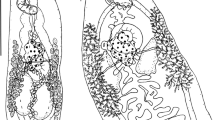Summary
We investigated the occurrence of cranial lesions caused by helminth parasites in the European polecat Mustela putorius in a museum collection in Slovakia. Selected traits of polecat body morphology and condition were studied with respect to the prevalence of the parasites, and number and extent of helminth-caused lesions in crania of 183 adult polecats. The trematode Troglotrema acutum was identified as the parasitic agent (prevalence 62.6 %), with a strong relationship between number of lesions and extent of cranial damage (surface of cranium). Prevalence of infection did not differ significantly between sexes (68.9 % in females, 51.1 % in males). Females with lesions by Troglotrema acutum have significantly greater braincase breadth than uninfected ones. Among males, infected individuals were generally significantly heavier and larger than uninfected individuals. Therefore, contrary to assumptions, it seems that parasites did not influence significantly body measurements of the animals, and differences are probably rather a result of an intra-sample age variation among infected polecats (older individuals are bigger, more probably infected and damage is more pronounced).
Similar content being viewed by others
References
Adamec, M. (2003): [Mammals and new legislation in nature and landscape protection]. In: Adamec, M., and Urban, P. (Eds) Proceedings of conference Research and protection of mammals in Slovakia VI. State Nature Conservancy of Slovak Republic, Zvolen (In Slovak)
Addison, E. M., Strickland, M. A., Stephenson, A. B., Hoeve, J. (1988): Cranial lesions possibly associated with Skrjabingylus (Nematoda: Metastrongyloidea) infections in martens, fishers, and otters. Can. J. Zool., 66: 2155–2159
Anisimova, E. I. (2002): Comparative analysis of the helminthocenoses of otter (Lutra lutra) and polecat (Mustela putorius) in Belarus. Helminthologia, 39: 87–90
Artois, M., Blancou, J., Gerard, Y. (1982): Parasitisme du putois (Mustela putorius) par Troglotrema acutum. Revue Méd. Vét., 133: 771–777
Blanford, P. R. S. (1987): Biology of the polecat Mustela putorius: a literature review. Mamm. Rev., 17: 155–198
Bowman, J., Tamlin, A. L. (2007): The effect of sinus nematode infection on braincase volume and cranium shape in the mink. J. Mammal., 88: 946–950
Brzeziński, M., Romanowski, J. (1997): Tchórz. Wydawnictwo Świat, Warszawa
Buchalczyk, T., Ruprecht, A. L. (1977): Skull variability of Mustela putorius L. 1758. Acta theriol., 82:87–120
Buskirk, S. W., Harlow, H. J. (1989): Body-fat dynamics of the American marten (Martes americana) in winter. J. Mammal., 70: 191–193
DeMarinis, A. M. (1995): Craniometric variability of polecat Mustela putorius L. 1758 from North-Central Italy. Hystrix, 7: 57–68
Goater, C. P., Holmes, J. (1997): Parasite-mediated natural selection. In Clayton, D.H., and Moore, J. (Eds): Host-Parasite Evolution: General Principals and Avian Models. Oxford University Press, Oxford.
Górski, P., Zalewski A., Łakomy, M. (2006): Parasites of carnivorous mammals in Białowieża Primeval Forest. Wiad. Parasitol., 52: 49–53
Hansson, I. (1968): Cranial helminth parasites in species of Mustelidae. I. Frequency and damage in fresh mustelids from Sweden. Oikos, 19: 217–233
Kierdorf, U., Kierdorf, H., Konjević, D., Lazar, P. (2006): Remarks on cranial lesions in the European polecat (Mustela putorius) caused by helminth parasites. Vet. Arhiv., 76(Suppl.): 101–109
King, C. M. (1977): The effect of the nematode parasite Skrjabingylus nasicola on British weasels (Mustela nivalis). J. Zool., 182: 225–249
King, C. M. (1991): Age-specific prevalence and a possible transmission route for Skrjabingylosis in New Zealand stoats, Mustela erminea. N.Z. J Ecol., 15: 23–30
Koubek, P, Barus, V, Koubkova, B. (2004): Treglotrema acutum (Diginea) from carnivores in the Czech Republic. Helminthologia, 41: 25–31
Møller, A. P. (1997): Parasitism and the evolution of host life history. In: Clayton, D.H. and Moore, J. (Eds) Host-Parasite Evolution: General Principles and Avian Models. Oxford University Press, Oxford.
Santi, S. A., Parker, G. H., Schaffner, N. P., Capodagli, L., Persinger, M. A. (2006). Prevalence, intensity, and geographic distribution of sinus worm (Skrjabingylus nasicola) infection in mink (Mustela vison) of central Ontario. Can. J. Zool., 84: 1011–1018
Schmidt, K. (1993): Changes in frontal sinuses of weasel (Mustela nivalis) in Poland possibly caused by nematodes or trematodes. Wiad. Parazytol., 39: 241–245
Vogel, H., Voelker, J. (1978): Über den Lebenszyklus von Treglotrema acutum. Tropenmed. Parasit., 29: 385–405
Walton, K. C. (1968): The baculum as an age indicator in the polecat Putorius putorius. J. Zool., 156: 533–536
Author information
Authors and Affiliations
Corresponding author
About this article
Cite this article
Demuth, J., Hromada, M., Krawczyk, A.J. et al. Cranial lesions caused by helminth parasites and morphological traits in the European polecat Mustela putorius . Helminthologia 46, 85–89 (2009). https://doi.org/10.2478/s11687-009-0017-8
Received:
Accepted:
Published:
Issue Date:
DOI: https://doi.org/10.2478/s11687-009-0017-8




